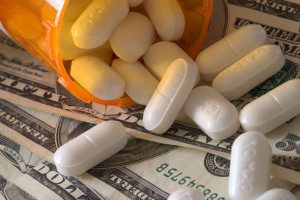Blindsided by a leukemia diagnosis at age 26, an otherwise healthy single mom named Lauren Baumann learned there’s a medicine for her illness that would help her live. It’s Gleevec. And the stars were aligned – she had a full time job and health insurance. So what’s the problem?
The problem is, as reported by NBC News, the once-a-day pill sold by Novartis comes at a wholesale price that exceeds $76,000 a year. Retail costs are much higher. Even with insurance, Lauren faces co-pays of $24,000 (and up) each year. Every year. For life.
Such expensive meds would seriously limit anyone’s life choices. How many of us could support a family, pay off student loan debt, save for retirement or just take a vacation once in a while if we had to pay that much for our medicine?
 This isn’t anything new. Americans have been quietly struggling with unaffordable medications for decades, stoically cutting pills in half, taking every-other-dose, or simply gritting our teeth and foregoing medication altogether. In fact, most of us are one surprise diagnosis away from your money or your life health care. In a 2013 abstract on the financial toxicity of cancer treatment published in the National Council of Biotechnology Information, researchers note “Health insurance does not eliminate financial distress or health disparities among cancer patients.”
This isn’t anything new. Americans have been quietly struggling with unaffordable medications for decades, stoically cutting pills in half, taking every-other-dose, or simply gritting our teeth and foregoing medication altogether. In fact, most of us are one surprise diagnosis away from your money or your life health care. In a 2013 abstract on the financial toxicity of cancer treatment published in the National Council of Biotechnology Information, researchers note “Health insurance does not eliminate financial distress or health disparities among cancer patients.”
Why do drugs cost so much, anyway? We’re told: “The pharmaceutical industry is leading the world in developing new medications that save lives. It costs millions to jump through the hoops of FDA regulations to manufacture new medicines. Pharmaceutical companies are taking a big financial risk and they need to be compensated for it.”
That sounds sort of reasonable, if only it were the whole story – which it’s not. Dr. Hagop Kantarjian, of the University of Texas’ MD Anderson Cancer Center, told CNN Money, “These price increases do not reflect the cost of development of drugs or the benefit they provide to the patient…They are simply related to the drug companies’ wish to increase profits beyond a reasonable range.”
What’s a “reasonable range?” In 2013, Pfizer enjoyed a 42% profit margin on total revenues of $51.6 billion. Yes, 42%. They spent only $6.6 billion on research & development. Over $11 billion went to marketing! This is not “reasonable.”
Didn’t Obamacare solve this? No. Relief from high prescription drug costs is not in sight. In fact, by June 2015, prescription drug spending increased over 13%.
Yet there IS hope! At last, the medical community is fighting back – at least when it comes to cancer drugs. Dr. Ayalew Tefferi, a hematologist at the Mayo Clinic, and 117 other doctors from around the country developed 7 recommendations to make cancer drugs more affordable.
These eye-opening recommendations were published online, in Mayo Clinic Proceedings, on July 23, 2015.
Check out the link for a complete list of the recommendations but here are a few:
- Eliminate unethical industry-wide practices such as “pay-for-delay” and “patent evergreening.”
Pay-for-Delay, a practice which delays generic drug competition and
Patent Evergreening, when old drugs are tinkered with and re-patented;
- Allow Medicare to negotiate for drug prices, like many other countries’ health systems have done for decades.
- Give patients the freedom to use chemotherapy drugs from abroad where prices are often significantly lower than in the USA.
Finally, after decades of silence and inaction, the medical community is starting to push back. It’s time for us all to add our voices to theirs in support of fair drug prices.
If you agree that we all deserve a healthcare system that works, join HEAL California! Stay informed and get involved. Better care is within reach, but only if we fight for it.

[…] example, NBC News told the story of Lauren Baumann, a healthy single mom who at age 26 discovered she had leukemia. She learned […]